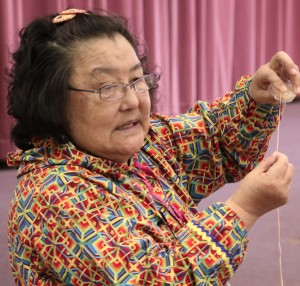Recently, about a dozen students gathered at the Cultural Center in Bethel to learn the traditional art of ‘gut sewing’. Seal intestines were prized throughout Yup’ik history for their waterproof performance before modern materials took hold. And now culture bearers are trying to bring back the skill.
For most students, today is the first time they have ever worked with guts.
Their 71-year-old instructor however, Mary Tunuchuk, has a lifetime of experience with the traditional material. She says imarnitet or “gut parkas” were critical for survival in her youth.
“The waterproof gut parkas were very important for men while hunting in the ocean. The way it reacts to moisture makes it a more effective insulated raincoat than most modern raincoats. In my first memories, women would learn to make raincoats, and other waterproof items before they get married, to ensure a better chance at survival. These days I never see anyone practice the art anymore,” said Tunuchuk.

Revitalizing the practice is part of the goal of the workshop, hosted by Bethel’s Yupiit Piciryarait Cultural Center and sponsored by the Smithsonian Arctic Studies Center and the Anchorage Museum. Besides parkas, seal intestines were used to make all kinds of waterproof items like bags, mittens, boot-linings and even windows. Curator Sarah Owens explains students will be using two kinds of material.
“There’s going to be a mixture of Native students who will be using seal intestine that Mary’s providing, but there’s also going to be non-Native students like myself and we will be using a substitute. We’ll be using hog intestine to sew with because it’s actually illegal for us to be sewing the seal intestine,” said Owens.
Tunuchak explains the process starts with the raw seal intestines, which are washed. She uses a dull scraper to remove the soft fleshy material from a membrane, which later is painstakingly cleaned of any flesh or blood. It’s washed in brine or freshwater before being inflated like a long balloon and hung to dry.
Tunuchuk taught the class the basics of sewing and the use of taperrnaq or grass as spacers between seams.
“It’s not just any grass, it’s beach grass, they are flexible and we use them around the seams so we could tighten the thread without breaking the membrane. You have a tighter more reinforced waterproof seam, without tearing the intestine,” said Tunuchuk.
The students bent the edges of the material with their mouths, using their saliva to make the material more flexible and hold its shape while sewing.
Students end up having made an amber colored translucent window. In ancient times, the window would have served as more of a skylight, called tanqin, Yup’ik for ‘something that brightens’.
Bethel resident, Annie Roach says she’s at the class because she wanted to connect with her culture.
“I’ve heard about some of the traditional skills and practices. I’ve always wanted to learn and now I understand a small part of it,” said Roach.
Yupiit Piciryarait Cultural Center staff say there are plans for more workshops exploring traditional skills, like a doll making class in the last week of March, and a fish skin crafting class later in April. The seal intestines for the class were provided by Mary Tunuchuk, who processed the intestine from seals caught by her children ad grandchildren.
Charles Enoch is a reporter at KYUK in Bethel.




